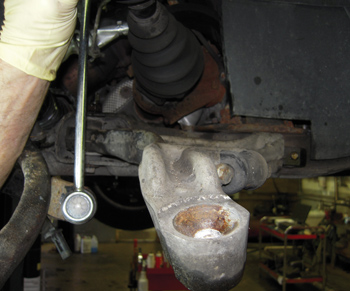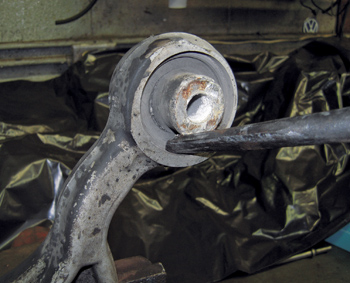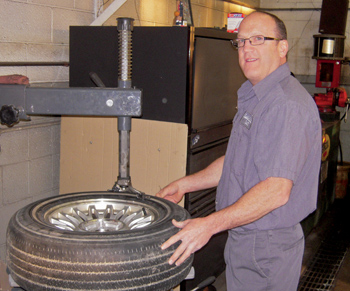wise. Our engine serial number is after 3188689, so we have the later tensioner.
> Turn the crank slowly and carefully clockwise until the belt is tight between the intake cam, the idler pulley and the crankshaft. Hold the center screw on the tensioner so it won’t move. Turn the eccentric clockwise until the indicator passes the two marking ears, and then turn it back so that it is in the middle of the two marking ears. This should be done on a cold engine that is approx. 70° F.
> Hold the tensioner in position and tighten the center screw on the tensioner to 20 Nm (see Photo 15). Make sure the indicator is still in the proper position. Once secured, you should be able to push on the timing belt and the tensioner indicator should move easily.
 > Turn the crankshaft two full turns clockwise and double-check your timing marks. If everything looks good, reinstall the front timing cover, the upper cover and the serpentine belt. Now would be a good time to replace the old serpentine belt, if it hasn’t been done in a while. Also check the power steering reservoir and coolant expansion tank. Make sure all the power steering and coolant hoses are routed correctly and secured.
> Turn the crankshaft two full turns clockwise and double-check your timing marks. If everything looks good, reinstall the front timing cover, the upper cover and the serpentine belt. Now would be a good time to replace the old serpentine belt, if it hasn’t been done in a while. Also check the power steering reservoir and coolant expansion tank. Make sure all the power steering and coolant hoses are routed correctly and secured.
>Install the crossbar and secure the inner fender liner. Remove the lower control arms and press in the new bushings before you put the wheel back on. It’s easy to see the rear bushing in the front control arm is completely separated (see Photo 16).
 Down Under
Down Under
> Disconnect the ball joint (see Photo 17) and remove the three bolts that hold the control arm to the chassis, two for the front bushing and one for the back. We put the control arm in the vise (see Photo 18) and use an air chisel that easily removes the old bushing.
> Clean the inner surface and move over to the press. The bushing has been in the freezer for a couple of hours so that helps it slide in much easier. Volvo has a special tool for this procedure, but a large socket and the press plate work really well. When installed, the distance between the lower part of the control arm and the top of the bushing should be 40 mm. Make sure the suspension is loaded at ride height before torqueing the control arm bolts. 
> We did both front control arms and then gave the car a good alignment. A good alignment is making sure the alignment specifications are in the middle of the acceptable range, preferably optimal and not just barely in the acceptable range. We don’t want our new tires to show any abnormal wear.
> We changed the oil, installed the new battery and put in a new cabin filter. We replaced both window regulator rollers and made sure the windows went up, as well as down. Our long-time expert tech John (see Photo 19), who did most of the work on the car, mounted up the new snow tires and put the finishing touches on the XC70. We test-drove the car and got it ready to deliver.
These days, money is a little tighter and customers sometimes fix only what they “have” to fix. Sooner or later, they’ll reach a point, especially if they have been putting off repairs, when a choice will have to be made — Do I put $2,000-$3,000 into my old car or buy a newer car? With your guidance, your customers can make an intelligent, informed decision. It seems to me more and more people are fixing up their older cars. This is good news for independent repair shop owners like us. Let’s get busy and help them.
The Aftermarket ‘Sweet Spot’
Older-age Vehicles Continue to Fuel Service Opportunities for the Aftermarket
An educational approach to inform customers how preventive maintenance can further extend the life of their vehicle, improve performance and use less gas can be a primary driver of service and repair sales on older-age vehicles.
There are 180 million “older” vehicles (6 years and older) on the road. That breaks down as: 73 million in the 6-10-year range and 107 million in the 11-plus-year range.
The aftermarket stands to gain more than $3 billion in Do It For Me (DIFM) service business over the next three to four years based on data from R.L. Polk and IMR.













